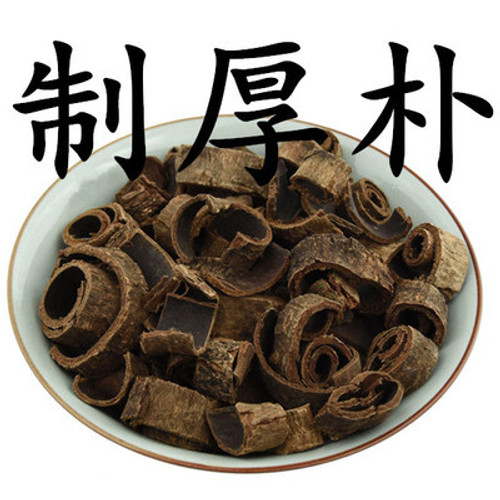Product Overview
Parts used: Dried stem bark, root bark or branch bark
TCM category: Aromatic herbs that transform Dampness
TCM nature: Warm
TCM taste(s): Bitter Pungent
Meridian affinity: Spleen Stomach Lung
Scientific name: Magnolia officinalis
Use of houpu magnolia bark (Hou Po) in TCM
Please note that you should never self-prescribe TCM ingredients. A TCM ingredient is almost never eaten on its own but as part of a formula containing several ingredients that act together. Please consult a professional TCM practitionner, they will be best able to guide you.
Preparation: Scrape off the rough skin, wash, break into sections and dry.
Dosage: 3 - 9 grams
Main actions according to TCM*: Moves Rebellious Qi downward, dries Dampness and relieves Food Stagnation. Transforms Phlegm and redirects Rebellious Qi of the Lung.
Primary conditions or symptoms for which houpu magnolia bark may be prescribed by TCM doctors*: Abdominal pain Abdominal bloating Constipation Dyspnea Coughing Vomiting Diarrhea
Contraindications*: This herb should not be used by pregnant women or by those with Stomach or Spleen Deficiency.
Common TCM formulas in which houpu magnolia bark are used*:
For bloating, nausea and vomiting caused by blocked Qi of the Spleen and Stomach combine houpu magnolia bark with amomum fruits (Sha Ren) and tangerine peel (Chen Pi).
For an invasion of External Wind and Cold in summer with chills, fever, headache, nausea, vomiting and diarrhea combine houpu magnolia bark with korean mint (Huo Xiang), perilla leaves (Zi Su Ye), crow-dipper rhizomes (Ban Xia) and tangerine peel (Chen Pi).
For retching, nausea, diarrhea and abdominal pain due to cold in the Stomach combine houpu magnolia bark with long peppers (Bi Ba), lesser galangal rhizomes (Gao Liang jiang) and costus roots (Mu Xiang).
For Damp-Cold in the Spleen combine houpu magnolia bark with tsaoko fruits (Cao Guo) and atractylodes rhizomes (Bai Shu).
Key TCM concepts behind houpu magnolia bark (Hou Pu)'s properties
In Traditional Chinese Medicine (TCM), houpu magnolia bark are plants that belong to the 'Aromatic herbs that transform Dampness' category. This category of herbs resolves a TCM condition called 'Cold Damp Stagnation', especially as it affects the Stomach and Spleen. In modern medicine this often translates into symptoms such as distended chest and abdomen, lack of appetite, nausea and vomiting
As suggested by its category houpu magnolia bark are plants that are Warm in nature. This means that houpu magnolia bark tend to help people who have too much "cold" in their body, although with less effect than a plant that would be Hot in nature. Balance between Yin and Yang is a key health concept in TCM. Those who have too much cold in their body are said to either have a Yin excess (because Yin is Cold in nature) or a Yang deficiency (Yang is Hot in Nature). Depending on your condition houpu magnolia bark can help restore a harmonious balance between Yin and Yang.
Houpu Magnolia bark also taste Bitter and Pungent. The so-called "five elements" theory in Chinese Medicine states that the taste of TCM ingredients is a key determinant of their action in the body. Bitter ingredients like houpu magnolia bark tend to have a cleansing action on the body by clearing heat, drying dampness and promoting elimination via urination or bowel movements. On the other hand Pungent ingredients tend to promote the circulations of Qi and body fluids. That's why for instance someone tends to sweat a lot when they eat spicy/pungent food.
The tastes of ingredients in TCM also determine what organs and meridians they target. As such houpu magnolia bark are thought to target the Spleen, the Stomach and the Lung. In TCM the Spleen assists with digestion, blood coagulation and fluid metabolism in the body. The Stomach on the other hand is responsible for receiving and ripening ingested food and fluids. It is also tasked with descending the digested elements downwards to the Small Intestine. In addition to performing respiration, the Lungs are thought to be a key part of the production chain for Qi and the body fluids that nourish the body.






